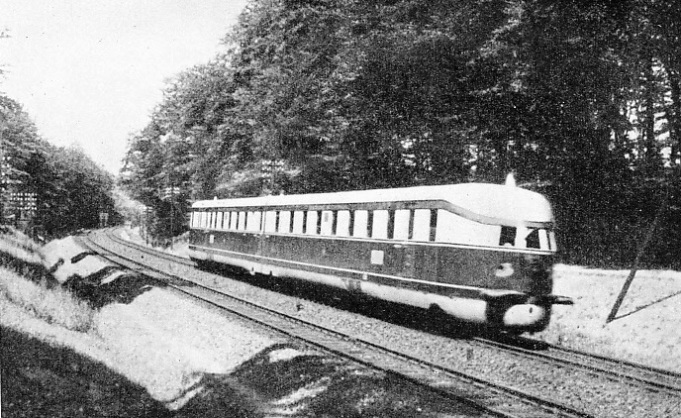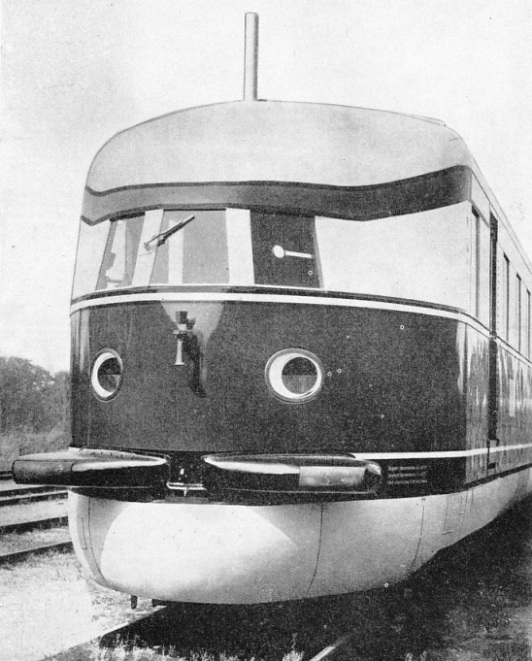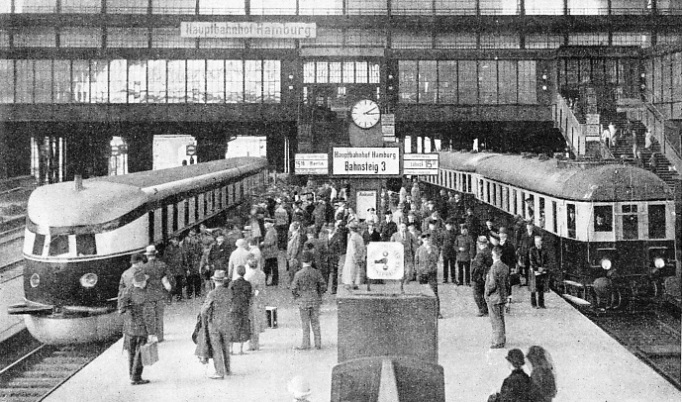
© Railway Wonders of the World 2012-


The “Flying Hamburger”
Germany’s Contribution to Streamline Design

ROUNDING A CURVE at high speed -
THE almost frantic development of speed in all forms of transport has not left the railways untouched, as we have already seen. Britain, France, Germany and other countries have made a beginning -
To travel on the “Flying Hamburger” type of train is an experience in itself, but one that must, in time, become a part of normal transport. The “Flying Hamburger” type takes the place of the “F.D.” (long distance) trains. It carries 102 passengers and reaches a maximum speed of 100 miles per hour, with an average speed of 77·4 miles per hour from Berlin to Hamburg and 76.3 miles per hour in the reverse direction, on the run of 178·1 miles. The fare on this train costs no more than that of a second-
The successful trips of this new method of transport in Germany have already impressed the world. The train has been so extensively filmed, and generally publicized that the Zeppelin airship could well be envious of the fame achieved overnight by its competitor. Anything so popular had to have a popular name, and after three had been proposed it was decided to use the description “Flying Hamburger”.
When viewed from the front the train bears a remarkable resemblance to a grotesque face, as will be seen from the illustration on the following page. It cannot be called a “Zeppelin on rails”, since it lacks the propellers of the fast train, constructed by the engineer Kruckenberg of Hanover, which reached a maximum speed of 124·26 miles per hour; but it certainly is appropriately called the “Flying Hamburger”.
The secret of this flying wonder’s speed lies partly in the fact that its constructors have succeeded in reducing air resistance to a minimum. To find the most practical shape, specially constructed models were blown through the so-

STREAMLINED FOR SPEED, the “Flying Hamburger” presents a remarkable appearance at the front end. The wheels are shielded by a sheet metal apron, and above this is a pair of cushion-
In the effort to reduce the resistance of the air, the body of the train itself had to be made as light as possible. The motors, therefore, in contrast with the American constructions of electrically-
Airship Technique Applied
No genius falls from heaven, according to an old proverb, and in like manner no technical wonder is born overnight. In an attempt to construct the fastest train in the world, the German Reichsbahn has been carrying on experiments with motored wagons for many years. Only the employment of 12-
There are no separate compartments in this train. Each of the coach’s halves is one large saloon, with seats for about fifty persons. On one side of the corridor are sections of two seats facing one another, each accommodating three persons, and on the other side are two corner seats for one person each. Luggage is cared for in the baggage-
There is a bar in the middle of the train. It is just large enough for the barkeeper. It is, like the kitchens in the “Mitropa” dining-
Fifteen minutes after leaving the Berlin station, as soon as the yards and switches of the city are left behind, the speedometer reaches 130 kilometres, and then moves up surely and rapidly to 160, which is almost exactly 100 mph. The clicks at the joints of the rails follow one another ever more speedily, until they finally merge into a continuous song. The landscape flits by, and the names of the stations can hardly be read, since the “Flying Hamburger” flashes through them so swiftly.
All danger of accidents has been reduced to as near the vanishing point as is humanly possible. There are as many as four different ways of applying the brakes. If the motorman or his assistant should pass an adverse signal, the train would be automatically brought to a stop by an inductive braking system worked from the signal.
This automatic electric braking begins at the first warning signal, which stands three-
Speeds up to 100 miles an hour for all through trains on the main lines is the goal at which the German railways are now aiming, and it is for this reason that more highly perfected safety measures are being devised. Hence, a special department has been created in the central operating division in Berlin for the development of control mechanisms. The intention is to instal generally the electro-
The newly-
Special Signalling
At all precautionary or stop signals along the line magnets tuned to the same frequency are attached, protected by cases. If the signal stands at “track clear”, the magnet of the locomotive is not influenced. If it stands at “stop”, however, different results ensue.
The first experiments in this direction were made with a magnet of only one frequency in the locomotive, but the most modern apparatus permits the generating of three different frequencies. A frequency of 500 cycles per second brings a full stop at the main signal, one of 1,000 cycles per second a warning at the precautionary signal, and a frequency of 2,000 cycles per second draws the engineer's attention to the fact that he is exceeding the permissible speed.

TWO ARTICULATED COACHES comprise the complete high-
If the engineer passes a warning signal, the train is automatically braked ten seconds later, unless he presses the so-
Of great importance is the fact that speeds, automatic braking and the use of the “attention lever” are noted on a special recording device. It is thus possible to check the engineer’s actions from the beginning to the end of his journey.
About 1,600 miles of the German railway system have already been equipped with inductive signals, and the work is proceeding rapidly. The six new motorized trains, after the style of the “Flying Hamburger”, to be operated on the Berlin-
There is no doubt that Germany has made extraordinarily rapid progress in the design and operation of streamlined speed trains. The journey from Berlin to Hamburg is the fastest schedule in the world, though comparatively short in mileage, and the presence of fog does not appear to make much difference to the speed of the train, thanks to the methods of signalling described above.
Even when the train is moving at nearly 100 miles an hour there is little, if any, vibration and the passenger is hardly aware of the speed at which he is travelling. To travel in the engineer’s cabin is another story. Here the impression of speed is pronounced, but the two engineers (both capable of driving the train) are not concerned by it. They are too intent on their tasks and too familiar with the experience. The popularity of the German streamlined train is already well established, for the “Flying Hamburger” is generally well-
The German plan is to speed up railway development by substituting motor coaches wherever possible, running at higher speeds and shorter intervals, and paying the minutest attention -
The general German speed-
It means, too, the readjustment of the curves on many miles of track, changing the distance between signals, and the solving of the problem of bringing trains to a standstill in the shortest space of time with minimum discomfort to the passengers. In this way Germany has become one of the most railway-

HAMBURG STATION with the “Flying Hamburger” on the left, and on the right the “Flying Lubecker”, a high-
You can read more on “Germany and Holland”, “Some German Achievements” and “Speed Trains of Europe” on this website.